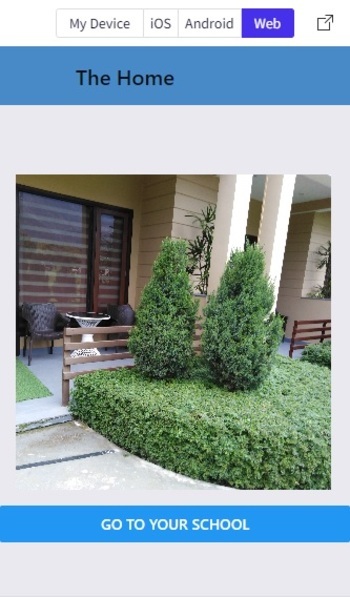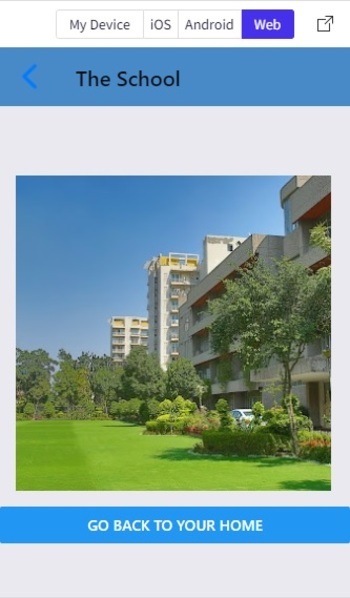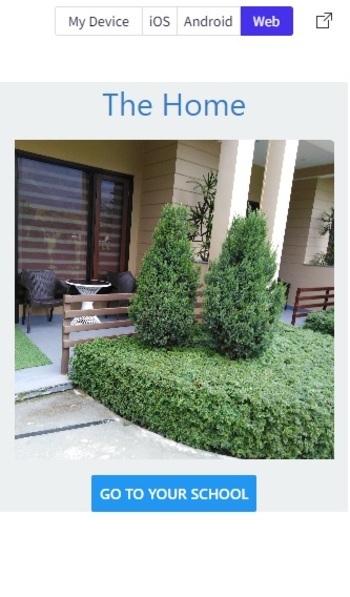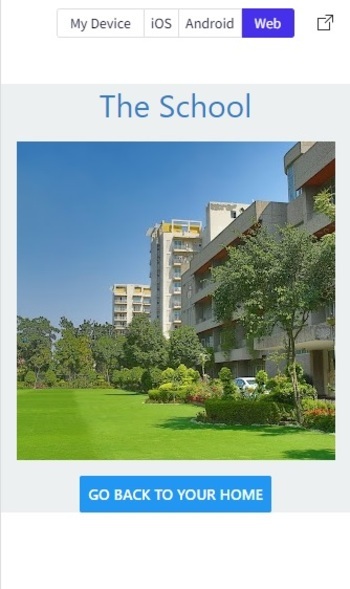在Snack中创建双屏应用
在React Native应用中,通常需要使用多个屏幕,并且用户需要从一个屏幕切换到另一个屏幕。本文介绍了制作双屏应用的两种不同方法,用户可以在屏幕之间进行切换。在示例1中,我们使用了’react-navigation’中的createStackNavigator模块来实现导航,而在示例2中,我们使用createSwitchNavigator来创建导航。
步骤
步骤1
步骤1 - 从’react-navigation’中导入createStackNavigator模块
步骤2 - 创建App.js并在javascript文件中编写从一个屏幕导航到另一个屏幕的代码
步骤3 - 在App.js文件中创建两个屏幕类(My_Home和My_School)
步骤4 - 设置导航选项,如标题和头部样式
步骤5 - 编写从My_Home导航到My_School再回到My_Home的代码
步骤6 - 即时在线上查看结果
步骤2
步骤1 - 创建一个screens文件夹,并创建名为FirstScreen.js和SecondScreen.js的javascript文件,在这些文件中编写FirstScrr和SecondScrr的代码
步骤2 - 从’react-navigation’库中导入createAppContainer和createSwitchNavigator模块
步骤3 - 创建App.js并编写从FirstScrr到SecondScrr再回到FirstScrr的代码
步骤4 - 使用按钮的onPress()函数实现从FirstScrr到SecondScrr再回到FirstScrr的跳转
步骤5 - 即时在线上查看结果
多种方法
我们提供了不同的解决方案:
- 使用’react-navigation’中的createStackNavigator模块
- 使用’react-navigation’库中的createAppContainer和createSwitchNavigator模块
让我们逐个查看程序及其输出。
方法1:使用’react-navigation’中的createStackNavigator模块
项目中的重要文件
- App.js
- Package.json
- 两个图片文件myhome.jpg和myschool.jpg
App.js: 这是主要的javascript文件。
示例
import {Component} from 'react';
import { Button,Image, View } from 'react-native';
import {createStackNavigator} from 'react-navigation';
export default class TheTwoScreenApp extends Component {
render() {
return <TheTwoScreenNavigator />;
}
}
class My_Home extends Component {
navopt = {
title: 'The Home',
headerStyle: {backgroundColor:"#499AC8"}
};
render() {
return (
<View
style={{
flex: 1,
justifyContent: 'center'
}}>
<Image
style={{ width: 300, height: 300, margin:15 }}
source={require('./myhome.jpg')} />
<Button
title="Go to Your School"
onPress={() =>
this.props.navigation.navigate('My_School')
}
/>
</View>
);
}
}
class My_School extends Component {
navopt = {
title: 'The School',
headerStyle: {backgroundColor:"#499AC8"}
};
render() {
return (
<View
style={{
flex: 1,
justifyContent: 'center',
}}>
<Image
style={{ width: 300, height: 300, margin:15 }}
source={require('./myschool.jpg')} />
<Button
title="Go back to Your Home"
onPress={() =>
this.props.navigation.navigate('My_Home')
}
/>
</View>
);
}
}
const TheTwoScreenNavigator = createStackNavigator(
{
My_Home: My_Home,
My_School: My_School,
},
);
Package.json :这是包含所需依赖项的文件。
示例
{
"dependencies": {
"react-navigation": "2.0.0-rc.2",
"@expo/vector-icons": "^13.0.0"
}
}
查看结果
起始屏幕输出
结果可以在线上查看。

显示启动屏幕(主页)作为Web视图
下一个屏幕输出
如果用户从第一个屏幕点击按钮,导航会跳转到下一个屏幕。

显示下一个屏幕(学校)作为Web视图。
方法2:使用createAppContainer和createSwitchNavigator来自库’react-navigation’
项目中重要的文件
- 文件夹名称屏幕中包括FirstScreen.js和SecondScreen.js
-
App.js
-
两个图像文件myhome.jpg和myschool.jpg
FirstScreen.js:这是包含FirstScrr代码的javascript文件
示例
import {Component} from 'react';
import {View,Button, Text, Image, StyleSheet} from 'react-native';
export default class FirstScrr extends Component {
render() {
return (
<View style={styles.mainSpace}>
<Text style={{textAlign:"center", fontSize:30, color: "#357EC7"}}>The Home</Text>
<Image
style={{ width: 304, height: 304, margin:15, paddingTop: 40}}
source={require('../myhome.jpg')} />
<Button
title="Go to Your School"
onPress={() =>
this.props.navigation.navigate('SecondScrr')
}
/>
</View>
);
}
}
const styles = StyleSheet.create({
mainSpace: {
flex: 1,
alignItems: 'center',
justifyContent: 'center',
marginTop: 36,
backgroundColor: '#ecf0f1',
},
});
SecondScreen.js:这是包含 Second Screen 代码的javascript文件
示例
import{Component}from'react';
import{View,Button,Text,Image,StyleSheet}from'react-native';
exportdefaultclassSecondScrrextendsComponent{
render(){
return(
<Viewstyle={styles.mainSpace}>
<Textstyle={{textAlign:"center",fontSize:30,color:"#357EC7"}}>TheSchool</Text>
<Image
style={{width:304,height:304,margin:15}}
source={require('../myschool.jpg')}/>
<Button
title="GobacktoYourHome"
onPress={()=>
this.props.navigation.navigate('FirstScrr')
}
/>
</View>
);
}
}
conststyles=StyleSheet.create({
mainSpace:{
flex:1,
alignItems:'center',
justifyContent:'center',
marginTop:36,
backgroundColor:'#ecf0f1',
},
});
App.js:这是此项目的主要 JavaScript 文件。
示例
import {Component} from 'react';
import {View} from 'react-native';
import { createAppContainer, createSwitchNavigator } from 'react-navigation';
import FirstScrr from './screens/FirstScreen';
import SecondScrr from './screens/SecondScreen';
export default class TheTwoScreenDemoExample extends Component {
render() {
return (
<View>
<AppBox />
</View>
);
}
}
var AppNav = createSwitchNavigator({
FirstScrr: FirstScrr,
SecondScrr: SecondScrr,
});
const AppBox = createAppContainer(AppNav);
查看结果
第一屏输出
结果可以在线上看到。

在Web View中显示FirstScreen
第二个屏幕输出
如果用户从FirstScreen点击按钮,导航将进入SecondScreen。

将第二个屏幕显示为Web视图。
本文介绍了两种在应用程序中使用多个屏幕的方法。使用两种不同的导航方式演示了如何从一个屏幕导航到另一个屏幕。在第一种方法中,使用StackNavigator,而在第二种方法中使用SwitchNavigator。
 极客笔记
极客笔记